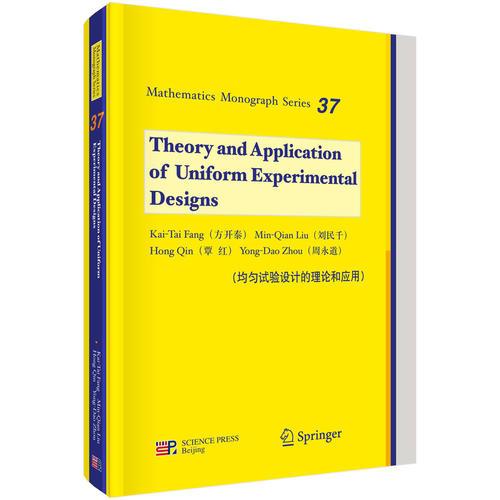均匀试验设计的理论和应用(英文版)
出版时间:
2018-12
版次:
31
ISBN:
9787030591104
定价:
149.00
装帧:
其他
开本:
16开
页数:
300页
字数:
350千字
2人买过
-
均匀试验设计是将数论方法应用到试验设计的一种设计方法,其可用于模型未知的和实验室试验及计算机试验。近三十年来,均匀试验设计理论得到长足发展,其已广泛应用于工程、自然科学研究、制药、高科技产品的研制之中。本书将全面介绍均匀试验设计的理论、均匀测度、构造方法及在试验设计中的应用,尤其侧重于其理论方面的阐述。
1 Introduction1.1 Experiments1.1.1 Examples1.1.2 Experimental Characteristics1.1.3 Type of Experiments1.2 Basic Terminologies Used1.3 Statistical Models1.3.1 Factorial Designs and ANOVA Models1.3.2 Fractional Factorial Designs1.3.3 Linear Regression Models1.3.4 Nonparametric Regression Models1.3.5 Robustness of Regression Models1.4 Word-Length Pattern: Resolution and Minimum Aberration1.4.1 Ordering1.4.2 Defining Relation1.4.3 Word-Length Pattern and Resolution1.4.4 Minimum Aberration Criterion and Its Extension1.5 Implementation of Uniform Designs for Multifactor Experiments1.6 Applications of the Uniform DesignExercisesReferences2 Uniformity Criteria2.1 Overall Mean Model2.2 Star Discrepancy2.2.1 Definition2.2.2 Properties2.3 Generalized L2-Discrepancy2.3.1 Definition2.3.2 Centered Discrepancy2.3.3 Wrap-around L2-Discrepancy2.3.4 Some Discussion on CD and WD2.3.5 Mixture Discrepancy2.4 Reproducing Kernel for Discrepancies2.5 Discrepancies for Finite Numbers of Levels2.5.1 Discrete Discrepancy2.5.2 Lee Discrepancy2.6 Lower Bounds of Discrepancies2.6.1 Lower Bounds of the Centered Lz-Discrepancy2.6.2 Lower Bounds of the Wrap-around Lz-Discrepancy2.6.3 Lower Bounds of Mixture Discrepancy2.6.4 Lower Bounds of Discrete Discrepancy2.6.5 Lower Bounds of Lee DiscrepancyExercisesReferences3 Construction of Uniform Designs——Deterministic Methods3.1 Uniform Design Tables3.1.1 Background of Uniform Design Tables3.1.2 One-Factor Uniform Designs3.2 Uniform Designs with Multiple Factors3.2.1 Complexity of the Construction3.2.2 Remarks3.3 Good Lattice Point Method and Its Modifications3.3.1 Good Lattice Point Method3.3.2 The Leave-One-Out glpm3.3.3 Good Lattice Point with Power Generator3.4 The Cutting Method3.5 Linear Level Permutation Method3.6 Combinatorial Construction Methods3.6.1 Connection Between Uniform Designs and Uniformly Resolvable Designs3.6.2 Construction Approaches via Combinatorics3.6.3 Construction Approach via Saturated Orthogonal Arrays3.6.4 Further ResultsExercisesReferences……4 Construction of Uniform Designs——Algorithmic Optimization Methods5 Modeling Techniques6 Connections Between Uniformity and Other Design Criteria7 Applications of Uniformity in Other Design Types8 Uniform Design for Experiments with MixturesSubject Index
作者介绍
序言
1 Introduction1.1 Experiments1.1.1 Examples1.1.2 Experimental Characteristics1.1.3 Type of Experiments1.2 Basic Terminologies Used1.3 Statistical Models1.3.1 Factorial Designs and ANOVA Models1.3.2 Fractional Factorial Designs1.3.3 Linear Regression Models1.3.4 Nonparametric Regression Models1.3.5 Robustness of Regression Models1.4 Word-Length Pattern: Resolution and Minimum Aberration1.4.1 Ordering1.4.2 Defining Relation1.4.3 Word-Length Pattern and Resolution1.4.4 Minimum Aberration Criterion and Its Extension1.5 Implementation of Uniform Designs for Multifactor Experiments1.6 Applications of the Uniform DesignExercisesReferences2 Uniformity Criteria2.1 Overall Mean Model2.2 Star Discrepancy2.2.1 Definition2.2.2 Properties2.3 Generalized L2-Discrepancy2.3.1 Definition2.3.2 Centered Discrepancy2.3.3 Wrap-around L2-Discrepancy2.3.4 Some Discussion on CD and WD2.3.5 Mixture Discrepancy2.4 Reproducing Kernel for Discrepancies2.5 Discrepancies for Finite Numbers of Levels2.5.1 Discrete Discrepancy2.5.2 Lee Discrepancy2.6 Lower Bounds of Discrepancies2.6.1 Lower Bounds of the Centered Lz-Discrepancy2.6.2 Lower Bounds of the Wrap-around Lz-Discrepancy2.6.3 Lower Bounds of Mixture Discrepancy2.6.4 Lower Bounds of Discrete Discrepancy2.6.5 Lower Bounds of Lee DiscrepancyExercisesReferences3 Construction of Uniform Designs——Deterministic Methods3.1 Uniform Design Tables3.1.1 Background of Uniform Design Tables3.1.2 One-Factor Uniform Designs3.2 Uniform Designs with Multiple Factors3.2.1 Complexity of the Construction3.2.2 Remarks3.3 Good Lattice Point Method and Its Modifications3.3.1 Good Lattice Point Method3.3.2 The Leave-One-Out glpm3.3.3 Good Lattice Point with Power Generator3.4 The Cutting Method3.5 Linear Level Permutation Method3.6 Combinatorial Construction Methods3.6.1 Connection Between Uniform Designs and Uniformly Resolvable Designs3.6.2 Construction Approaches via Combinatorics3.6.3 Construction Approach via Saturated Orthogonal Arrays3.6.4 Further ResultsExercisesReferences……4 Construction of Uniform Designs——Algorithmic Optimization Methods5 Modeling Techniques6 Connections Between Uniformity and Other Design Criteria7 Applications of Uniformity in Other Design Types8 Uniform Design for Experiments with MixturesSubject Index
-
内容简介:
均匀试验设计是将数论方法应用到试验设计的一种设计方法,其可用于模型未知的和实验室试验及计算机试验。近三十年来,均匀试验设计理论得到长足发展,其已广泛应用于工程、自然科学研究、制药、高科技产品的研制之中。本书将全面介绍均匀试验设计的理论、均匀测度、构造方法及在试验设计中的应用,尤其侧重于其理论方面的阐述。
-
目录:
1 Introduction1.1 Experiments1.1.1 Examples1.1.2 Experimental Characteristics1.1.3 Type of Experiments1.2 Basic Terminologies Used1.3 Statistical Models1.3.1 Factorial Designs and ANOVA Models1.3.2 Fractional Factorial Designs1.3.3 Linear Regression Models1.3.4 Nonparametric Regression Models1.3.5 Robustness of Regression Models1.4 Word-Length Pattern: Resolution and Minimum Aberration1.4.1 Ordering1.4.2 Defining Relation1.4.3 Word-Length Pattern and Resolution1.4.4 Minimum Aberration Criterion and Its Extension1.5 Implementation of Uniform Designs for Multifactor Experiments1.6 Applications of the Uniform DesignExercisesReferences2 Uniformity Criteria2.1 Overall Mean Model2.2 Star Discrepancy2.2.1 Definition2.2.2 Properties2.3 Generalized L2-Discrepancy2.3.1 Definition2.3.2 Centered Discrepancy2.3.3 Wrap-around L2-Discrepancy2.3.4 Some Discussion on CD and WD2.3.5 Mixture Discrepancy2.4 Reproducing Kernel for Discrepancies2.5 Discrepancies for Finite Numbers of Levels2.5.1 Discrete Discrepancy2.5.2 Lee Discrepancy2.6 Lower Bounds of Discrepancies2.6.1 Lower Bounds of the Centered Lz-Discrepancy2.6.2 Lower Bounds of the Wrap-around Lz-Discrepancy2.6.3 Lower Bounds of Mixture Discrepancy2.6.4 Lower Bounds of Discrete Discrepancy2.6.5 Lower Bounds of Lee DiscrepancyExercisesReferences3 Construction of Uniform Designs——Deterministic Methods3.1 Uniform Design Tables3.1.1 Background of Uniform Design Tables3.1.2 One-Factor Uniform Designs3.2 Uniform Designs with Multiple Factors3.2.1 Complexity of the Construction3.2.2 Remarks3.3 Good Lattice Point Method and Its Modifications3.3.1 Good Lattice Point Method3.3.2 The Leave-One-Out glpm3.3.3 Good Lattice Point with Power Generator3.4 The Cutting Method3.5 Linear Level Permutation Method3.6 Combinatorial Construction Methods3.6.1 Connection Between Uniform Designs and Uniformly Resolvable Designs3.6.2 Construction Approaches via Combinatorics3.6.3 Construction Approach via Saturated Orthogonal Arrays3.6.4 Further ResultsExercisesReferences……4 Construction of Uniform Designs——Algorithmic Optimization Methods5 Modeling Techniques6 Connections Between Uniformity and Other Design Criteria7 Applications of Uniformity in Other Design Types8 Uniform Design for Experiments with MixturesSubject Index
作者介绍
序言
1 Introduction1.1 Experiments1.1.1 Examples1.1.2 Experimental Characteristics1.1.3 Type of Experiments1.2 Basic Terminologies Used1.3 Statistical Models1.3.1 Factorial Designs and ANOVA Models1.3.2 Fractional Factorial Designs1.3.3 Linear Regression Models1.3.4 Nonparametric Regression Models1.3.5 Robustness of Regression Models1.4 Word-Length Pattern: Resolution and Minimum Aberration1.4.1 Ordering1.4.2 Defining Relation1.4.3 Word-Length Pattern and Resolution1.4.4 Minimum Aberration Criterion and Its Extension1.5 Implementation of Uniform Designs for Multifactor Experiments1.6 Applications of the Uniform DesignExercisesReferences2 Uniformity Criteria2.1 Overall Mean Model2.2 Star Discrepancy2.2.1 Definition2.2.2 Properties2.3 Generalized L2-Discrepancy2.3.1 Definition2.3.2 Centered Discrepancy2.3.3 Wrap-around L2-Discrepancy2.3.4 Some Discussion on CD and WD2.3.5 Mixture Discrepancy2.4 Reproducing Kernel for Discrepancies2.5 Discrepancies for Finite Numbers of Levels2.5.1 Discrete Discrepancy2.5.2 Lee Discrepancy2.6 Lower Bounds of Discrepancies2.6.1 Lower Bounds of the Centered Lz-Discrepancy2.6.2 Lower Bounds of the Wrap-around Lz-Discrepancy2.6.3 Lower Bounds of Mixture Discrepancy2.6.4 Lower Bounds of Discrete Discrepancy2.6.5 Lower Bounds of Lee DiscrepancyExercisesReferences3 Construction of Uniform Designs——Deterministic Methods3.1 Uniform Design Tables3.1.1 Background of Uniform Design Tables3.1.2 One-Factor Uniform Designs3.2 Uniform Designs with Multiple Factors3.2.1 Complexity of the Construction3.2.2 Remarks3.3 Good Lattice Point Method and Its Modifications3.3.1 Good Lattice Point Method3.3.2 The Leave-One-Out glpm3.3.3 Good Lattice Point with Power Generator3.4 The Cutting Method3.5 Linear Level Permutation Method3.6 Combinatorial Construction Methods3.6.1 Connection Between Uniform Designs and Uniformly Resolvable Designs3.6.2 Construction Approaches via Combinatorics3.6.3 Construction Approach via Saturated Orthogonal Arrays3.6.4 Further ResultsExercisesReferences……4 Construction of Uniform Designs——Algorithmic Optimization Methods5 Modeling Techniques6 Connections Between Uniformity and Other Design Criteria7 Applications of Uniformity in Other Design Types8 Uniform Design for Experiments with MixturesSubject Index
查看详情
-
全新
山东省济宁市
平均发货44小时
成功完成率83.53%
-
全新
北京市丰台区
平均发货9小时
成功完成率89.96%
-
全新
北京市通州区
平均发货10小时
成功完成率89.81%
-
全新
广东省广州市
平均发货10小时
成功完成率92.48%
-
全新
河北省廊坊市
平均发货12小时
成功完成率84.08%
-
全新
山东省泰安市
平均发货8小时
成功完成率92.21%
-
全新
山东省泰安市
平均发货6小时
成功完成率54.55%
-
全新
山东省泰安市
平均发货11小时
成功完成率91.69%
-
全新
天津市河东区
平均发货20小时
成功完成率92.61%
-
全新
北京市朝阳区
平均发货19小时
成功完成率91.28%
-
全新
四川省成都市
平均发货13小时
成功完成率80.59%
-
全新
北京市东城区
平均发货12小时
成功完成率57.69%
-
全新
广东省广州市
平均发货18小时
成功完成率93.68%
-
全新
广东省广州市
平均发货18小时
成功完成率95.48%
-
全新
天津市西青区
平均发货14小时
成功完成率91.46%
-
全新
-
全新
河北省保定市
平均发货21小时
成功完成率88.89%
-
全新
浙江省嘉兴市
平均发货17小时
成功完成率89.56%
-
全新
广东省广州市
平均发货18小时
成功完成率95.92%
-
全新
广东省广州市
平均发货17小时
成功完成率93.12%
-
 5
5
全新
北京市海淀区
平均发货23小时
成功完成率86.23%
-
全新
江苏省无锡市
平均发货7小时
成功完成率96.64%
-
全新
江苏省无锡市
平均发货14小时
成功完成率93.27%
-
全新
北京市海淀区
平均发货9小时
成功完成率91.99%
-
 2
2
全新
江苏省无锡市
平均发货11小时
成功完成率92.13%
-
全新
北京市通州区
平均发货45小时
成功完成率93.33%
-
 5
5
全新
北京市丰台区
平均发货26小时
成功完成率83.39%
-
全新
北京市海淀区
平均发货17小时
成功完成率82.18%
-
全新
河北省保定市
平均发货14小时
成功完成率87.69%
-
全新
北京市东城区
平均发货9小时
成功完成率96.42%
-
全新
江苏省南京市
平均发货11小时
成功完成率91.22%
-
全新
江苏省南京市
平均发货11小时
成功完成率93.4%
-
全新
江苏省南京市
平均发货17小时
成功完成率79.88%
-
全新
广东省广州市
平均发货9小时
成功完成率86.67%
-
全新
四川省成都市
平均发货7小时
成功完成率97.31%
-
全新
北京市房山区
平均发货17小时
成功完成率88.61%
-
全新
北京市通州区
平均发货10小时
成功完成率91.67%
-
全新
北京市通州区
平均发货9小时
成功完成率92.95%
-
全新
北京市西城区
平均发货16小时
成功完成率91.65%
-
全新
上海市浦东新区
平均发货24小时
成功完成率79.57%
-
全新
四川省成都市
平均发货18小时
成功完成率90.67%
-
全新
广东省广州市
平均发货16小时
成功完成率83.84%
-
全新
北京市朝阳区
平均发货13小时
成功完成率90.87%
-
 4
4
全新
江西省吉安市
平均发货45小时
成功完成率81.78%
-
全新
北京市朝阳区
平均发货14小时
成功完成率95.12%

 占位居中
占位居中





















































































